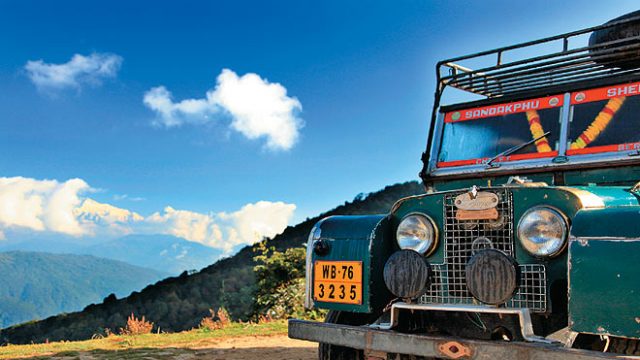When local authorities proposed a metalled road between Manebhanjang and Sandakphu, a collective gasp went up among drivers working the route. They argued that their vehicles — Land Rovers dating back to the 1950s — were not the right fit for tar-topped roads where other vehicles would do a better job. The boulder-paved bumpy delusion of a road that exists will do fine, thank you.
The trail to Sandakphu — the chilly, windswept pinnacle in the Darjeeling hills that is the perfect place to watch the sun rise over four of the world’s five highest peaks — is the raison d’être for this fleet of 50-odd Land Rovers. After decades of rutted rides, harsh weather and some very inventive repair jobs, these beasts are still quite capable of huffing and puffing their way up from the dusty trekkers’ stop at Manebhanjang (7,000ft) to Sandakphu (11,929ft). A handful also run the Darjeeling-Ghoom route, but that journey is less nerve-racking for passengers (and only half as testing for Land Rovers).
The British tea planters who introduced the Land Rovers to Darjeeling and Assam in the early 1950s figured that these sturdy, versatile four-wheel drive vehicles would be best for negotiating the region’s tough terrain. When the British planters left, these vehicles were bought by locals for use as passenger cars.
“The best thing about them?” asks Keshab Gurung, who inherited a 1954-make Land Rover from his father. He answers the question himself: “They don’t need a road at all. Tie a chain individually around the tyres and they’ll go up snow-covered tracks as well. We do that sometimes during emergencies in winter.” Gurung is a member of the Manebhanjang-based Singalila Land Rovers Association, possibly the only such association in the country.
Darjeeling hills are among the last outposts of commercial use for the old Land Rovers. A few of them even bear the iconic Series I markers (including the 80-inch wheelbase version), which was launched by the UK-based Rover Company at the Amsterdam Motor Show in 1948. Series II and III versions are also in use. Naturally, Darjeeling is a very profitable surfing area for vintage car enthusiasts. “Sturdy bodies, powerful engines, four-wheel drives and immense antique value — what else does one want of a car?” asks Rumba K., owner of the quaint Hot Stimulating Café in Darjeeling, who offers tourists a Land Rover ‘experience’.
The Land Rover has a charming, weather-beaten look, and the proprietary Birmabright (a lightweight alloy of aluminium and magnesium named possibly after Birmingham, where it was manufactured) body. Naturally, original parts are by and large unavailable, and so there’s a lot of innovation using Tata and Mahindra parts or other locally created bits.
We shared a vehicle with sacks of rice and sugar, cartons of mineral water and rum and a wicker basket full of chirping chicks — all of which are for villages and trekkers’ huts further up. As we stop for lunch at Shikhar Lodge, a graceful rest-house in otherwise barren Tumling, children run out to dust the vehicle and clean its tyres. And Nila Gurung, who runs the place, gets her share of the ration.
Just before we leave, she returns to offer a small prayer for the vehicle. There’s a long and arduous journey ahead for the Land Rover, after all.




